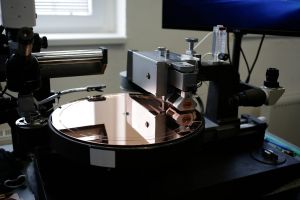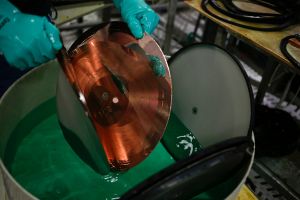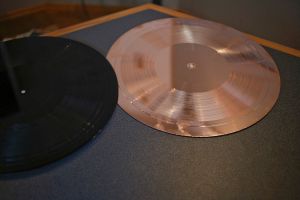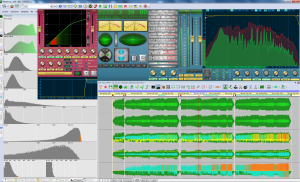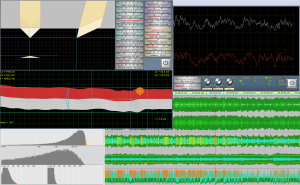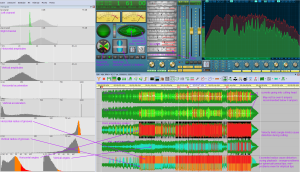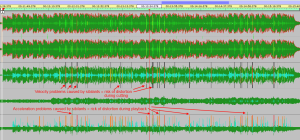DMM
DMM (Direct Metal Mastering) is one of the two existing technologies to create original (master) discs needed for vinyl record pressing. The other, older technology is cutting into a lacquer disc. The majority of our vinyl production is done using DMM, but lacquer cutting or processing of a supplied lacquer is available on request.
History
The DMM process was developed and issued in 1982 by a collaboration between two German companies Teldec and Georg Neumann GmbH.
Neumann was exclusively supplying the technology and mastering systems until the late 90's when the company left the music industry during the decline in popularity of vinyl records.
There are around 12 DMM cutting lathes operating in the whole world that produce masters for manufacturing vinyl records.
Interesting trivia: two DMM cutting lathes have been obtained by Church of Scientology, which supposedly uses them to record the speeches of their founder L.R.Hubbard and which are placed into "time-capsules" together with spring loaded phonographs. The idea behind that is if someone digs out and opens such capsule after a predicted apocalypse, they should be able to listen to Mr. Hubbard speeches without the use of electricity.
Even with the resurgence of vinyl records, no one has been able to manufacture a brand new DMM cutting lathe since their original batch produced in the 80's – 90's.
DMM Principle
DMM transcribes audio coming from a workstation or a master tape into a copper plate using a diamond cutting stylus (the copper that is being cut into is a plated layer on a non-magnetic steel substrate). This creates an original "positive" (master/mother) disc that is used to create a "negative" stamper in an electroforming galvanic process. Stamper is then attached onto a pressing machine and is used for a mass replication – pressing of vinyl records.
In comparsion with lacquer cutting, lacquer is cut into a nitrocellulose layer coated on an aluminium disc using a heated sapphire cutting stylus. Because nitrocellulose is not electrically conductive it needs to be sprayed with a thin layer of silver in order to be usable in a later electroforming galvanic process. We use traditional lacquer processing which includes three copies: "negative" (father), "positive" (mother), "negative" (stamper). Lacquer itself is consumed and discarded in the process.
Supplied lacquers should be sent for processing as soon as possible so the grooves cut into the soft nitrocellulose surface do not degrade due to heat and environmental conditions, typically resulting in a loss of high frequencies (unless the cutting lathe is right next to a galvanic processing room, in which case lacquers need to rest for several hours until they stop evaporating toxic gases after the cutting process, which would pose a health risk and could create "bubbles" due to evaporation under the immediately silvered layer).
Team DMM -vs- Team Lacquer
DMM and Lacquer cuts each have their own fans and supporters. Please note that neither technology is in no way a replacement for a proper mastering and recording process and all pros/cons of each technology can only account for the transcription onto a vinyl record as a physical medium.
DMM supporters typically list these advantages:
- more accurate reproduction of high frequencies (16kHz up)
- DMM allows for thinner groove (less noise, longer playtimes)
- better signal-to-noise ratio (even on a groove of the same width, DMM has about 7-10dB better S/N compared to lacquer)
- reduced print-through sounds (pre-echo, post-echo) between adjacent grooves
- only one subsequent electroforming step
Lacquer supporters typically list these advantages:
- bigger vertical amplitudes which can carry more out-of-phase low frequency signals
- wider and deeper grooves which are more tolerant for most kinds of surface damage
- wider horizontal groove angle available, reducing risk of loud mid frequencies causing harmonic distortion in higher frequencies
- the softer lacquer material allows very high cutting levels resulting in louder records
Horizontal amplitude is a movement of the tip of the stylus from left-to-right in the groove‘s path. Vertical amplitude is a movement up and down - deeper into the groove and back up. Horizontal amplitude carries most of the transcribed audio signal, vertical amplitude carries the difference between the left and right channel.
Thicker layer of lacquer allows for higher vertical amplitude and a different shape of cutting stylus allows cutting of bigger angles in the horizontal amplitude, it however carries a risk that the softer nitrocelulose layer (compared to DMM‘s copper layer) will „print-through“ the groove that is currently being cut and will deform neighbouring previously cut groove (pre-echo) or will deform the surface that will be cut into on the next revolution of the disc (post-echo, which is much less common).
Please note that higher volume and bigger vertical amplitudes also involve a higher risk of distortion and mistracking on some turntables.
Available DMM mastering options
Basic options we offer for DMM cutting are:
1. STANDARD CUT
Default option.
Minimizing risk of distortion on most turntables, only necessary edits are performed on the audio to achieve best possible sounding record.
Will be quiet compared to a typical lacquer cut, with less distortion and less surface noise.
2. LOUD CUT
Available on request.
Overall volume and loudness of the record will be comparable to most typical lacquer cuts, with higher risk of distortion in critical parts of the recording (loudest parts of the audio and near the center of the record). Reduced available playtime.
3. DJ LOUD CUT
Available on request.
Same as "LOUD CUT", but with wider groove that helps stability of the playing stylus (useful for playback in loud environments that produce a lot of vibrations). Wider groove results in higher surface noise and reduced available playtime. Visual separating grooves in-between tracks are done more prominent.
4. DJ LOUD CUT + SCRATCH
Available on request.
Same as "DJ LOUD CUT" but with even wider groove, resulting in maximum stability of the playing stylus. Even further reduction of available playtime.
5. FLAT CUT (*)
Available on request.
Cut is performed without any listenable alteration during premastering. Transcription will be done "as is" which can results in problematic cuts especially near the center of the record. Overall volume might be lower due to absence of other controlling parameters. Please make sure that you follow Vinyl master guidelines . Studio might refuse to cut, in which case you will receive a report on what should be changed to proceed.
If you want to avoid specific edits in premastering or cutting, please see "ASSISTED CUT / REFERENCE / SPECIAL REQUEST" instead.
(*) - be aware that many factories or studios refer to the "flat cut" as a best sounding cut with minimal alterations, which is mostly equivalent to our "1. STANDARD CUT".
6. (DISTORTION) SAFE CUT
Available on request.
Cut with an emphasis to minimizing risk of distortion on all types of playing styluses and cartridges. Might result in very quiet records with less distortion but higher surface noise.
7. ASSISTED CUT / REFERENCE / SPECIAL REQUEST
Available on request.
Do you want to visit us at Prague and be present during your cutting? Do you only want to use de-esser, but otherwise go with the "flat cut"? Do you want to achieve super-loudness similar to a record you own and are able to send us?
All of these options and more are available, keep in mind that they will be billed on an hourly rate of a mastering engineer.
VVM mastering, improvement to DMM cutting process
VVM (Vinyl Visual Mastering) is software tool designed specifically for needs of a vinyl mastering engineer (ME). It includes a state-of-art computer simulation of the mastering process that allows setting up cutting parameters and simulating the cutting process before the actual cutting is performed.
Consider a CAD system that is aiding an architect and is able to identify critical parts of the construction and address them specifically. That is what VVM achieves for a mastering engineer.
VVM allows for these main critical features:
- A very accurate virtual simulation which will find critical parts in supplied audio before the actual cut. Every cutting system needs to employ protections against critically high electrical current fed into the cutting head or critically high acceleration of the cutting stylus to avoid damaging the cutting head or stylus. In most cases this is done using an electrical circuit breaker and an acceleration limiter. Simulating the cut allows to address these critical conditions in a more sensitive and controlled manner with better results in the cut audio.
- Each order has individual settings, which can be adjusted for arbitrary parts of audio. There is a direct two-way communication between the computer and the cutting lathe
- Differential sound and graphic analysis can play or show differences between original audio and processed signal, feedback or vinyl record signal.
- Vinyl measuring system - geometric, physical, dynamic and load measurements in time or frequency domain.
- Groove processor - controls groove pitch, groove width and warps audio signals to compensate possible cutting and playback distortion. Every cut can have a different groove pitch strategy.
- Mathematical model of stylus and groove – the software computes a virtual groove based on geometric dimensions of a defined cutting stylus and can compare it visually with a real groove photo from a microscope.
- High quality non-destructive signal processing with unique vinyl algorithms. The original audio data remains untouched for a future use.
Summary
If you are mainly familiar with lacquer cuts and would achieve similar level of loudness with DMM, please specify that you would like to order a LOUD CUT during your order processing (please note that this is directly related to a possibility of higher distortion level in loudest parts of the recording). If you have a studio or a mastering engineer that supplies you with lacquer cuts you like, please state that you would like to use a supplied lacquer during your order.
In any case, if you are unsure, please add test pressings to your order to make sure you are okay with the sound before moving on to the main pressing.

